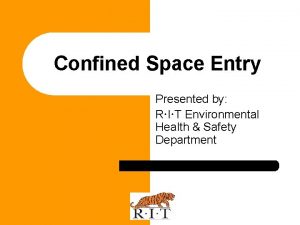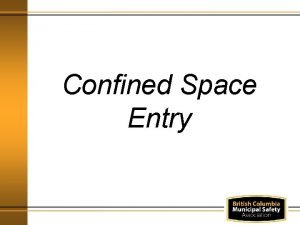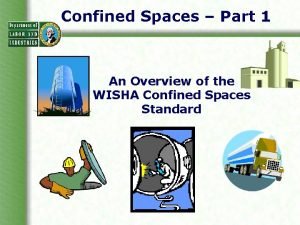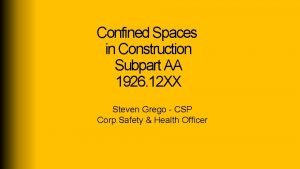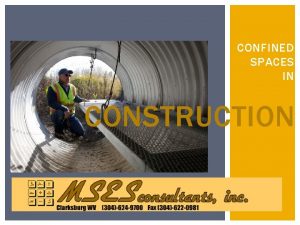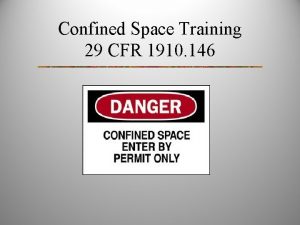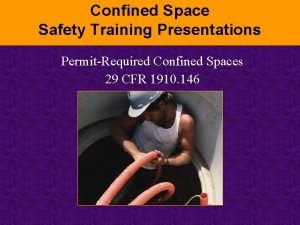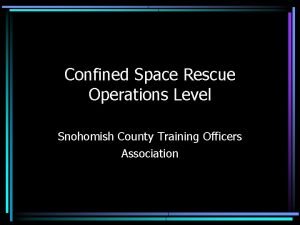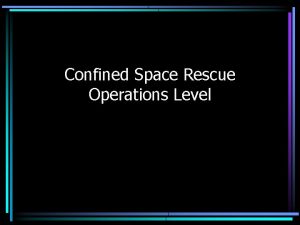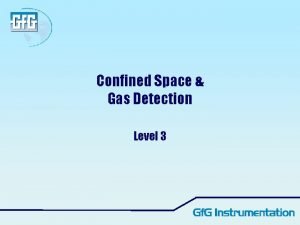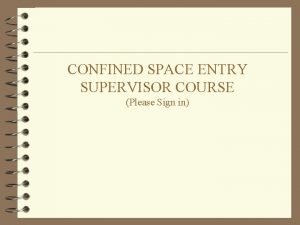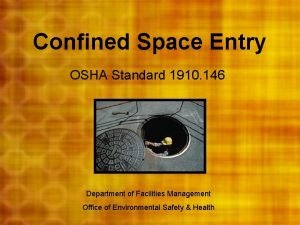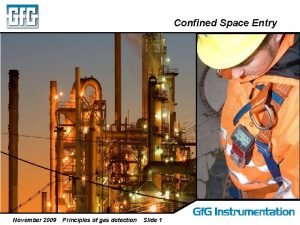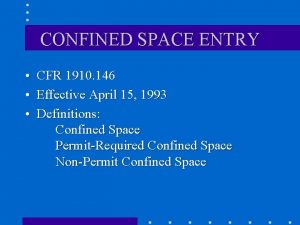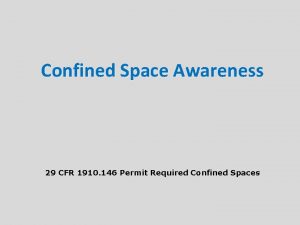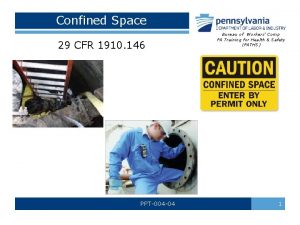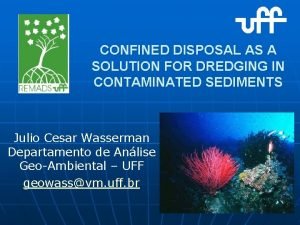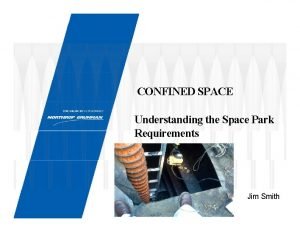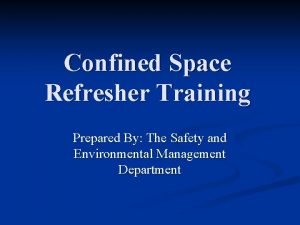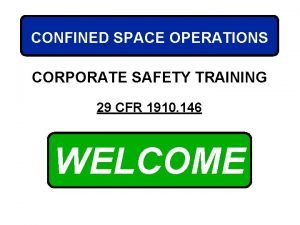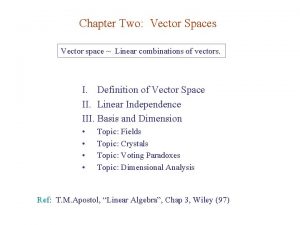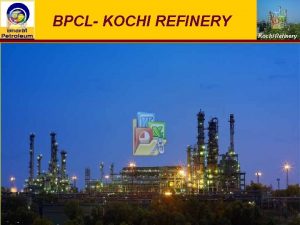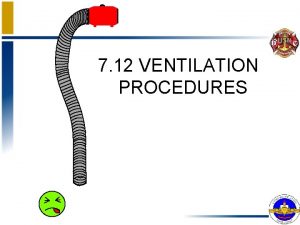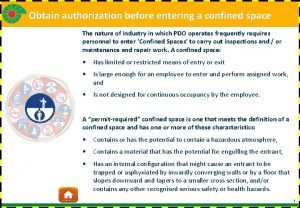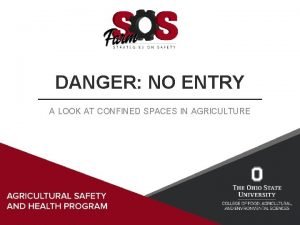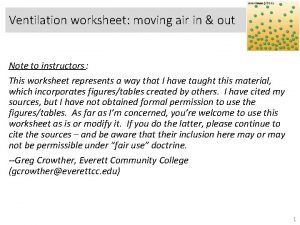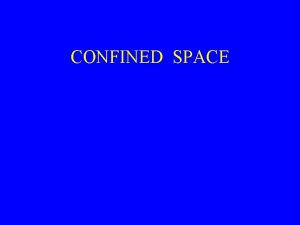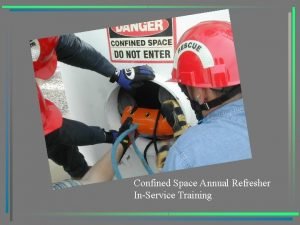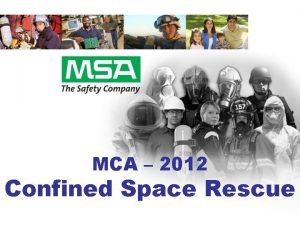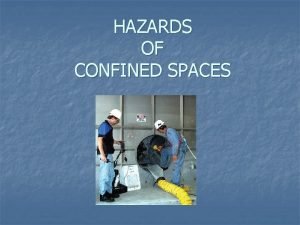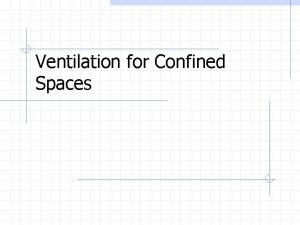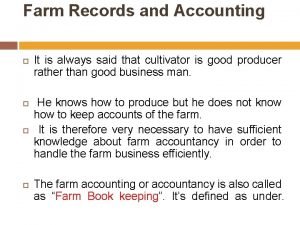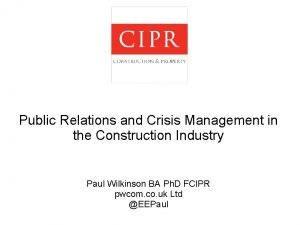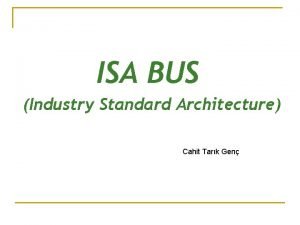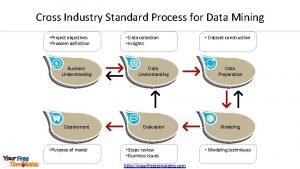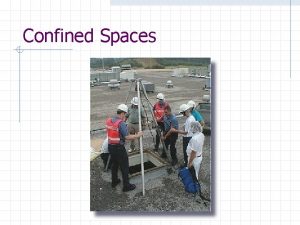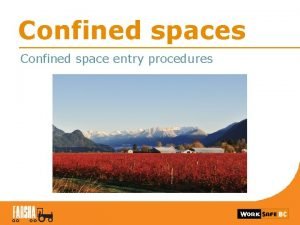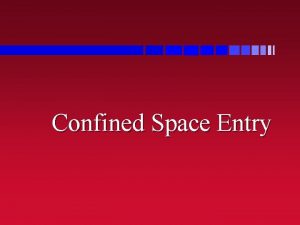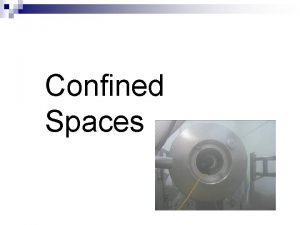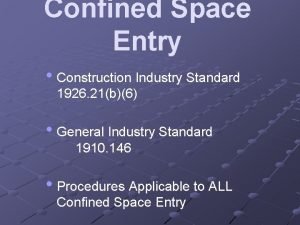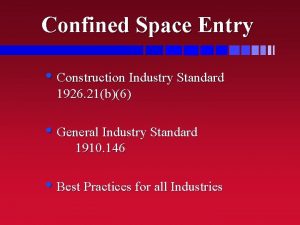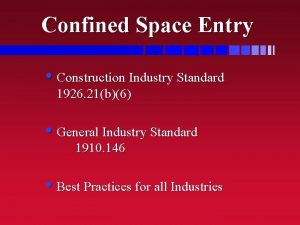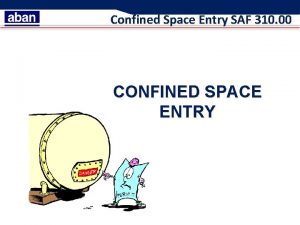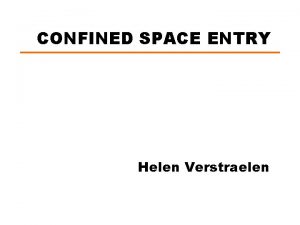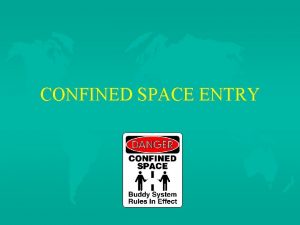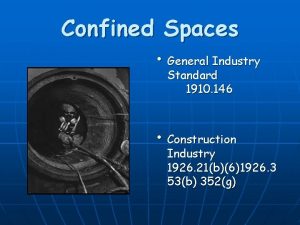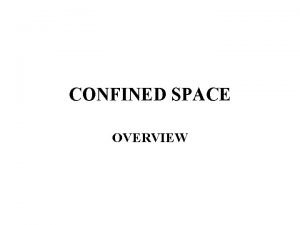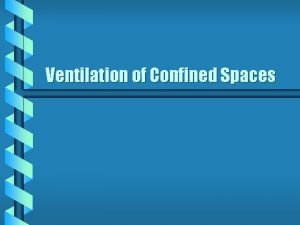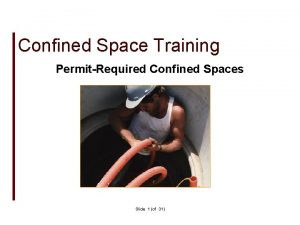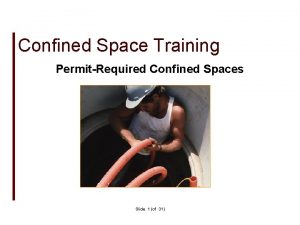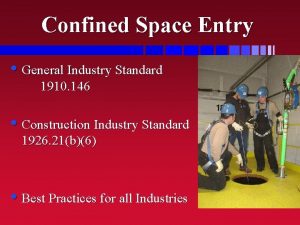Confined Spaces Confined Space Entry Construction Industry Standard














































- Slides: 46

Confined Spaces

Confined Space Entry • Construction Industry Standard 1926. 21(b)(6) and 5(a)(1) • General Industry Standard 1910. 146 • Best Practices for all Industries

Construction Industry Standard 1926. 21 (b)(6)(i) All employees required to enter into confined or enclosed spaces shall be instructed as to the nature of the hazards involved, the necessary precautions to be taken, and in the use of protective and emergency equipment required. The employer shall comply with any specific regulations that apply to work in dangerous or potentially dangerous areas.

1926. 21 (b)(6)(ii) n Confined or enclosed spaces include, but are not limited to, storage tanks, process vessels, bins, boilers, ventilation or exhaust ducts, sewers, underground utility vaults, tunnels, pipelines, and open top spaces more than 4 feet in depth such as pits, tubs, vaults, and vessels.

Typical Confined Spaces • Boiler, Degreaser, Furnace • Pipeline, Pit, Pumping Station • Reaction or Process Vessel, Mills • Septic Tank, Sewage Digestor • Silo, Storage Tank, Barges • Sewer, Utility Vault, Manhole • Trenches, Shafts, Caissons

ENTRY The action by which a person passes through an opening into a permit-required confined space, and includes ensuing work activities in that space. n Considered to have occurred as soon as any part of the entrant’s body breaks the plane of an opening into the space. n

The Three Elements of a Confined Space • Is large enough and so configured that an employee can bodily enter and perform assigned work; and • Has limited openings for entry and exit, • Unfavorable Natural Ventilation, and • Is not designed for continuous worker occupancy

Limited Openings for Entry/Exit • Openings as small as 12 inches in diameter. • Difficult to enter with SCBA or other lifesaving equipment. • Difficult to remove downed worker in folded up or bent over position. • Exit from large openings may be difficult due to presence of ladders, hoists, etc.

Unfavorable Natural Ventilation • Lack of air movement in and out of the space can create an atmosphere much different than the outside atmosphere. • Deadly gases can be trapped inside. • Organic materials can decompose. • May not be enough oxygen due to presence of other gases or chemical reactions such as rusting.

Not Designed for Continuous Worker Occupancy • Most confined spaces are not designed to enter and work in on a regular basis. • Designed to store a product. • Enclose materials or processes. • Transport products or substances. • Occasional worker entry for construction, inspection, repair, cleanup, maintenance, etc.

Dangerous Combinations • Presence of all three confined space characteristics • • • can complicate the situation. Working in and around the space. Rescue operations during emergencies. Worsened conditions due to work activities: – – – Welding and cutting, use of bonding agents, coatings Cleaning with solvents, use of other chemicals Use of gas-powered equipment

Categorizing Work Space * Space large enough to enter &; * Limited or Restricted entry or exit &; * Not designed for continuous worker occupancy. YES Permit. Required Confined Space NO Not a confined Space Confined Space Non Hazardous Atmosphere YES Or Engulfment Hazard Or Configuration Hazard Or Any other recognized serious hazard NO Permit Required Space

Hazards of Confined Spaces • Oxygen Deficient Atmospheres • Oxygen Enriched Atmospheres • Flammable Atmospheres • Toxic Atmospheres • Temperature Extremes • Engulfment and Entrapment Hazards • Noise, Slick/Wet Surfaces, Falling Objects • Machinery Hazards • Electrical Hazards

0% AL PEL PURE CLEAN FRESH AIR IDLH LEL UEL AL - ACTION LEVEL 100% PURE DIRTY AIR PEL - PERMISSIABLE EXPOSURE LIMIT (OSHA) REL - RECOMMENDED EXPOSURE LIMIT (NIOSH) TLV- THRESHOLD LIMIT VALUE (ACGIH) LEL - LOWER EXPLOSIVE LIMIT

Oxygen Deficient Atmospheres 19. 5 % 15 - 19% 12 -14% 10 -12% 8 -10% 6 -8% 4 -6% Minimum acceptable oxygen level. Decreased ability to work strenuously. Impair coordination. Early symptoms. Respiration increases. Poor judgment. Respiration labored. Lips blue. Mental failure. Fainting, Nausea, Unconsciousness, Vomiting. 8 minutes - fatal, 6 minutes - 50% fatal 4 -5 minutes - possible recovery. Coma almost instantaneously. Death

Oxygen Enriched Atmospheres • Oxygen level above 21%. • Causes flammable and combustible materials to burn violently when ignited. • Hair, clothing, materials, etc. • Oil soaked clothing and materials. • Never use pure oxygen to ventilate. • Never store or place compressed tanks in a confined space.

Flammable/Explosive Atmospheres • 3 Critical Factors: – Oxygen content in the air. – Presence of a flammable gas, vapor or dust » Proper air/gas/dust mixture can lead to either an explosion or a fire – Presence of a source of ignition » » » Typical Ignition Sources: Sparking or electric tool. Welding / cutting operations. Smoking Static Electricity

Toxic Atmospheres • Product stored in a confined space: » Gases released when cleaning. » Materials absorbed into walls of confined space. » Decomposition of materials in the confined space. • Work performed in a confined space: » Welding, cutting, brazing, soldering. » Painting, scraping, sanding, degreasing. » Sealing, bonding, melting. • Areas adjacent to a confined space.

Hydrogen Sulfide • Decomposition of materials. Human waste. • Rotten egg odor at low concentrations. • Possibly no warning at high concentrations due to olfactory fatigue. PPM Effect Time 10 ppm 50 - 100 200 - 300 500 -700 >1000 8 Hours 1 Hour 1/2 - 1 Hour Minutes Permissible Exposure Level Mild Irritation - eyes, throat Significant Irritation, headache Unconsciousness, Death

Carbon Monoxide • Odorless, Colorless Gas (no warning properties). • Combustion By-Product. • Quickly collapse at high concentrations. PPM 50 200 600 1000 -2000 2000 -2500 Effect Permissible Exposure Level Slight headache, discomfort Headache, discomfort Slight heart palpitation Tendency to stagger Confusion, nausea, headache Unconsciousness Time 8 Hours 3 Hours 1 Hour 30 Min. 1 1/2 Hours 30 Min.

Carbon Dioxide n Colorless odorless gas – Displaces oxygen leading to oxygen deficiency n Special problem in our area – Limestone Rock » Calcium Carbonate – Acidic topsoil – Acid leaches from soil, which then contacts the limestone producing Carbon Dioxide n Numerous fatalities – Especially in new sewer/vault leak testing using a vacuum – Pulls carbon dioxide into the space » Oxygen measured at less than 3%

ENGULFMENT n The surrounding and effective capture of a person by a liquid or finely divided (flowable) solid substance that can be aspirated to cause death by filling or plugging the respiratory system, or that can exert enough force on the body to cause death by strangulation, constriction, or crushing.

Engulfment Hazards • Loose, granular materials stored in bins and hoppers - grain, sand, coal, etc. • Crusting below a worker. • Bridging above a worker. • Flooding of confined space by materials. • Water or sewage flow. • Physical configuration of the space • Entrapment between sides or objects in the space

Temperature Extremes • Extremely hot or cold temperatures. • Steam cleaning of confined spaces. • Humidity factors. • Extremely cold liquids. • Work processes inside the confined space can increase temperature extremes. • Personal protective equipment use. • Solar load on outside of tank

Other Hazards • Noise » Amplified due to acoustics within the space. » Damaged hearing, affect communication. • Slick / Wet Surfaces » Slips and falls. » Increased chance of electric shock. • Falling Objects » Topside openings expose workers inside confined space to falling objects.

Machinery and Electrical Hazards (Sources of Stored Hazardous Energy Transfer) • Electrical sources. • Pneumatic and hydraulic lines. • Mechanical drives and shafts. • Moving mechanical parts. • Sharp or pointed parts • Sewer and water flow. • Locking and tagging out shutoff valves

Hazard Controls n OSHA’s Hierarchy of Control Measures – – – Engineering Controls Administrative Controls Personal Protective Equipment Recognition of Hazards Evaluation of Hazards Control of Hazards

Testing The Atmosphere • Verify presence of safe work atmosphere. • Test all areas of a confined space. – Top, Middle, Bottom • Methane (natural gas) is lighter than air. • Carbon Monoxide is the same as air. • Hydrogen Sulfide and Carbon Dioxide are heavier than air. • Oxygen Deficiency • Test for oxygen first. • Most “combination” meters require oxygen at normal ambient concentrations to work properly • Toxics • Flammables

Ventilation of Confined Spaces

Confined Space Ventilation Confined spaces are not normally designed for convenient ventilation n Must take steps to: n – ensure air is breathable before entering confined space – maintain acceptable air quality in the confined space during entry

Ventilation • First option to correct problems (Engineering Control). • Must be aware of hazards you are trying to correct in • • the confined space. Air intake in a safe location to draw fresh air only. Continuous ventilation whenever possible. • Required if your operations are generating contaminants within the space • Retest the confined space before re-entry.

Respirators • Air-Purifying Respirators – Filter dangerous substances from the air. – Must know the type and amount of hazardous substance present in the confined space. – NEVER use with oxygen deficiency! • Air-Supplying Respirators – Deliver a safe supply of breathing air from a tank or an uncontaminated area nearby. – Must be adequately monitored.

Isolation of Energy Sources • Locking and tagging out electrical sources. • Blanking and bleeding pneumatic and hydraulic lines. • Disconnecting mechanical drives and shafts. • Securing mechanical parts. • Blanking sewer and water flow. • Locking and tagging out shutoff valves.

Rescue in Confined Space

Standby / Rescue • Worker assigned to remain outside the • • • confined space and be in constant contact with the workers inside. Know emergency rescue procedures. 50% of workers who die in confined spaces are would-be rescuers. Trained in use of emergency rescue equipment and PPE.



Choosing the Appropriate Response n n n Decision: Stand-by Vs. Available Each entry must be evaluated to determine the appropriate response mode. The evaluation must be done by a qualified person (rescuer and/or entry supervisor). Factors to be considered include the severity of the hazard, required PPE, and the ability of the entrant to self-rescue.

Permit Entry Systems • Written permit signed by entry supervisor. • Verifies pre-entry precautions have been taken and the space is safe to enter. • Posted at entry to confined space. • Specifies apparent hazards and corrective actions taken prior to entry. • Requires termination of permit when task is completed or when new conditions exist.

Entry Permit Requirements • Date, location, and name of confined space. • Purpose of entry and known hazards. • Duration of entry permit time. • Authorized entrants, attendants, supervisors. • Air testing results - signature of tester. • Protective measures to be taken. » Ventilation, Isolation, Flushing » Lockout / Tagout, Purging

Entry Permit Requirements • Name and phone numbers of rescue and • • emergency services. Communication procedures. Special equipment and procedures. – – Personal protective equipment. Alarm procedures. Rescue equipment. Respirators.

Training and Education • All workers who must enter confined spaces • All attendants and rescue team members. • Prior to initial work assignment. • Retraining: » Job duties change. » Change in permit-space program. » New hazards are present. » Job performance indicates deficiencies.

Host Employer Requirements n When host employer arranges for contractor to perform permit space entry work, host employer shall: – Inform contractor of permit space entry program – Apprise contractor of hazards of particular permit spaces and precautions and procedures implemented for protection of employees in or near permit spaces; – Coordinate entry operations with contractor when both will be working in or near permit spaces and debrief contractor after entries. n Contractors shall inform the host employer of the permit program to be followed and coordinate entry operations.

Review n Failure to recognize confined space hazards is high on the list of accident causes

Analysis of confined space accidents identifies common causal factors : n n n Failure to conduct a thorough hazard assessment. Failure to ventilate the space adequately. Failure to control mechanical hazards. Lack of an appropriate rescue plan. Absence of retrieval harness and mechanical lifting devices. Absence of an attendant and entry supervisor

 Characteristics of confined space
Characteristics of confined space Confined spaces
Confined spaces Confined spaces
Confined spaces Confined space gas limits
Confined space gas limits Aa 1926
Aa 1926 Confined space meaning
Confined space meaning 29cfr1910.146
29cfr1910.146 Confined space training presentation
Confined space training presentation Saba confined space
Saba confined space Saba confined space
Saba confined space Lel meter readings
Lel meter readings Entry supervisor
Entry supervisor Confined space 1910
Confined space 1910 Uel and lel
Uel and lel 1910-146
1910-146 1910 146
1910 146 1910 confined space
1910 confined space Suspended particulate matter
Suspended particulate matter Confined space rescue equipment
Confined space rescue equipment Confined space refresher training
Confined space refresher training Confined space rescue equipment
Confined space rescue equipment Vector space
Vector space Confined space rescue equipment
Confined space rescue equipment Ventilation calculation formula for confined space
Ventilation calculation formula for confined space Obtain authorization before entering a confined space
Obtain authorization before entering a confined space Agricultural confined space training
Agricultural confined space training Confined space presentation
Confined space presentation Ventilation worksheet
Ventilation worksheet Confined space quiz
Confined space quiz Confined space refresher training
Confined space refresher training Confined space classification
Confined space classification Confined space rescue equipment
Confined space rescue equipment Confined space definition bc
Confined space definition bc What gas is heavier than air
What gas is heavier than air Advantages of single entry system
Advantages of single entry system What is new entry in entrepreneurship
What is new entry in entrepreneurship What is single entry system
What is single entry system Barriers to entry beer industry
Barriers to entry beer industry Impact of gst on construction industry
Impact of gst on construction industry Public relations construction industry
Public relations construction industry Accidents in construction industry
Accidents in construction industry Kennedy space center construction
Kennedy space center construction What is isa bus
What is isa bus Cross industry standard process for data mining
Cross industry standard process for data mining Unscented trajectory chapter 5
Unscented trajectory chapter 5 Space junk the space age began
Space junk the space age began Camera space to world space
Camera space to world space

